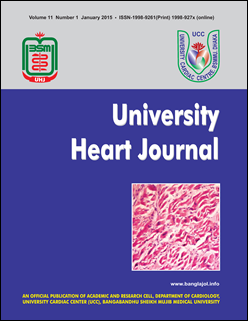Comparison of in Hospital Outcome of Patients with and without Distorted Terminal Portion of QRS Complex on Initial Electrocardiogram in ST Segment Elevation Myocardial Infarction
DOI:
https://doi.org/10.3329/uhj.v11i1.27597Keywords:
STEMI, Distorted QRS, Death, Heart failure, Cardiogenic shockAbstract
Background: Distorted terminal portion of QRS complex on initial electrocardiogram in ST segment elevation myocardial infarction is a strong predictor of inhospital adverse outcome.
Objectives: Our purpose of this study was to analyse admission ECG in patients of STEMI based on terminal portion of QRS complex and find out inhospital death, heart failure, cardiogenic shock and recurrent MI.
Methods: We evaluated 60 patients of STEMI admitted within 12 hours and receiving thrombolytic therapy. We defined two ECG groups according to absence of distortion of terminal QRS (Group-I) and presence of distorted terminal QRS (Group-II) in two or more adjacent leads. Group-II further divided into pattern-A J point originating at ?50% of height of R wave in leads with qR configuration and pattern B- S wave is absent in leads with RS configuration.
Results: Out of 60 patients of STEMI, 30(50.0%) patients had distortion of QRS. There were 7(11.6%) deaths, 16(26.7%) heart failure, 3(5.0%) cardigenic shock and no recurrent myocardial infarction. Hospital mortality and heart failure were found to be significantly higher in distorted QRS group (3.3% vs. 20.0%, p=0.04; 13.3% vs. 40.0%, p=0.02; respectively), cardiogenic shock of both groups did not show significant difference (0.0% vs. 10.0%, p=0.075). Multiple logistic regression analysis using hospital mortality as dependable variable and all studied risk factors were independent variables, QRS distortion on admission ECG and Killip class were only variable found to be statistically significant (OR=7.25, p value < 0.05 ; OR=16.25, p value < 0.05 respectively).
Conclusion: Careful analysis of ECG which is simple, cheap, universally available bed side investigation may offer important prognostic information in patients with STEMI and would help in deciding which patients should go urgent myocardial revascularization procedure.
University Heart Journal Vol. 11, No. 1, January 2015; 30-35
Downloads
181
212

